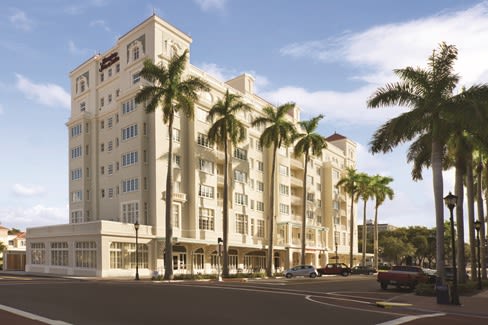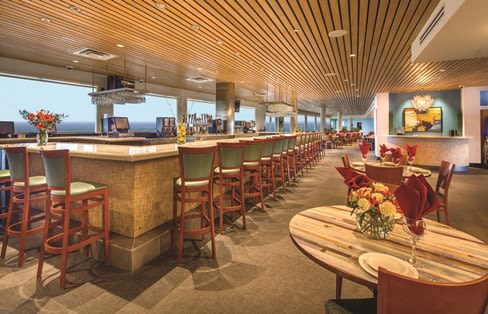Design Stars
by Ilene Denton
Photography by Gene Pollux
Three winning commercial renovations.
Commercial construction is back from the depths of the Great Recession, albeit not with the same flurry of intensity that residential building has taken on this year. Here are three recent commercial renovations that rate the cool factor.

PROJECT: Studio of Clifford M. Scholz Architects
ARCHITECT: Clifford M. Scholz, AIA, LEED AP, FGBG, NCARB
SCOPE OF WORK: Extreme renovation of the Ludwig Walpole building at 300 S. Orange Ave. in Sarasota.
OBJECTIVE: To bring a 1955 building into the 21st century. “When we got it, it pretty much looked like it did in 1955, with drop ceilings, flesh-colored cabinets and teal rugs. It was in good shape, but dated,” says Scholz.
THE LOOK: The shape and proportion of the building, and its “funky Fifties” roofline enticed Scholz to take on the project. “In doing renos like this,” he says, “I look at solids and voids in a more contemporary fashion. I thought, ‘Oh my god, all of the basic proportions are there, it’s just the wrong materials.’” Inside, the interior walls and ceilings were removed. “When we pulled the cedar paneling off, the outside of it was painted but the inside was natural. We refashioned it into the wainscoting in my office, a very sustainable way to get what I thought was a really cool look—and save money, too.”
BIGGEST CHANGE: Natural northern light now floods the building, thanks to replacing 80 percent of the northern and eastern exterior walls with glass. “A lot of times, we don’t even turn the lights on,” says the architect. A varying pattern of metal window muntins adds a contemporary look.
THAT’S CLEVER: Oversized cardboard blueprint tubes were repurposed into a hanging sculpture to hide a series of bookshelves in the reception area, and to act as mailboxes for Scholz and his nine employees.

PROJECT: Hampton Inn and Suites, Bradenton Downtown Historic District
DEVELOPER: Syracuse, N.Y.-based Widewaters Hotels
SCOPE OF WORK: A $21 million restoration of the dilapidated, 1920s-era Manatee River Hotel, a historic landmark affectionately known as “The Pink Palace,” into the 119-room Hampton Inn and Suites.
OBJECTIVE: To modernize the building while retaining its historic look and feel. “It was a shame the condition it was in,” says Robert Spoto, vice president of operations for owner-operator Widewaters Hotels. “A lot of developers wanted to demo it and start over; [but] we’d just finished another historic hotel project in Kansas City, The Elms Hotel, and we knew what you get into with that. Once you make the commitment and you do it right, there’s no way a brand-new cookie-cutter hotel could have same special feel.”
THE DETAILS: Key historic components were retained—the terrazzo lobby floor (hidden under carpet for decades), hand-stenciled beams, detail work around the exterior awnings and overhangs. “At the very top, there’s a pillar on each corner with beautiful aqua-green tile that had been painted over,” says Spoto. “As we were scraping it, it was pretty exciting to identify it. Those kinds of details cost more money, but we felt would set us apart from any other hotel in the area.” Above the lobby floor, “we pretty much did gut it because there wasn’t a lot to work with,” he says.
NICE REWARDS: Business has exceeded all expectations, says Spoto. “The Hampton Inn brand has a six-month window of ‘ramp-up’ before it expects a new project to stabilize; we hit that number within two months of opening.” And last spring, the restoration project earned an award from the Florida Trust for Historic Preservation.

PROJECT: The BeachHouse Restaurant on Bradenton Beach
CLIENT: Chiles Restaurant Group
ARCHITECT: Barron Schimberg, AIA, LEED AP, Schimberg Group
SCOPE OF WORK: Interior renovation of the 11,000-square-foot dining room, bar, retail store restrooms and kitchen.
OBJECTIVE: Upgrade a tired, 20-year-old restaurant. “There was no consistency to it,” says the architect, “just a hodgepodge of design decisions over the course of 20 years, very dark wood, a dark, low ceiling.” This was Schimberg’s second project for the client; his firm renovated The Sandbar in 2012.
THE LOOK: Faux-finished walls were painted colors of the sea. A wine wall, similar to the one installed at the Sandbar, provides some drama. The ceiling is cypress; and the flooring, composed of woven vinyl strands, is by Chilewich, the maker of high-design Chilewich placemats. “It’s almost indestructible,” says Schimberg. The architectural firm designed the tables and chairs; even though the tabletop surfaces look like real wood, they’re actually photos of wooden slats that have been imprinted onto the tables.
BIGGEST CHANGE: Schimberg moved the bar from a hard-to-find location behind the retail shop. “Now when you walk in, the bar is front and center facing the Gulf. It becomes a focal point, a place where energy happens; it becomes a different restaurant,” he says.
WHAT’S NEXT: Schimberg is set to start extensive renovations of The BeachHouse exterior—adding a second-floor deck on the Gulf side and redoing the existing ground-floor deck, plus a new porte-cochere and canopy facing Gulf Drive. “Going to be pretty amazing… imagine a huge pavilion with floating decks as part of the columns that hold up the roof,” he says.